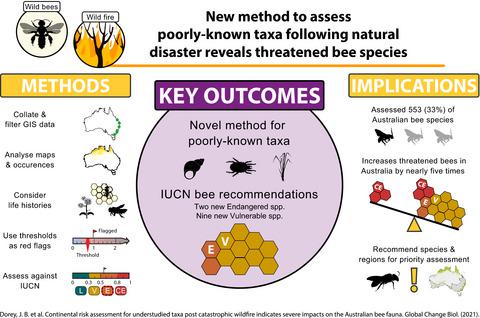当前位置:
X-MOL 学术
›
Glob. Change Biol.
›
论文详情
Our official English website, www.x-mol.net, welcomes your
feedback! (Note: you will need to create a separate account there.)
Continental risk assessment for understudied taxa post-catastrophic wildfire indicates severe impacts on the Australian bee fauna
Global Change Biology ( IF 10.8 ) Pub Date : 2021-09-30 , DOI: 10.1111/gcb.15879 James B Dorey 1, 2 , Celina M Rebola 1 , Olivia K Davies 1 , Kit S Prendergast 3 , Ben A Parslow 2 , Katja Hogendoorn 4 , Remko Leijs 2 , Lucas R Hearn 1 , Emrys J Leitch 5 , Robert L O'Reilly 1 , Jessica Marsh 2, 6 , John C Z Woinarski 7, 8 , Stefan Caddy-Retalic 5, 9
Global Change Biology ( IF 10.8 ) Pub Date : 2021-09-30 , DOI: 10.1111/gcb.15879 James B Dorey 1, 2 , Celina M Rebola 1 , Olivia K Davies 1 , Kit S Prendergast 3 , Ben A Parslow 2 , Katja Hogendoorn 4 , Remko Leijs 2 , Lucas R Hearn 1 , Emrys J Leitch 5 , Robert L O'Reilly 1 , Jessica Marsh 2, 6 , John C Z Woinarski 7, 8 , Stefan Caddy-Retalic 5, 9
Affiliation

|
The 2019–2020 Australian Black Summer wildfires demonstrated that single events can have widespread and catastrophic impacts on biodiversity, causing a sudden and marked reduction in population size for many species. In such circumstances, there is a need for conservation managers to respond rapidly to implement priority remedial management actions for the most-affected species to help prevent extinctions. To date, priority responses have been biased towards high-profile taxa with substantial information bases. Here, we demonstrate that sufficient data are available to model the extinction risk for many less well-known species, which could inform much broader and more effective ecological disaster responses. Using publicly available collection and GIS datasets, combined with life-history data, we modelled the extinction risk from the 2019–2020 catastrophic Australian wildfires for 553 Australian native bee species (33% of all described Australian bee taxa). We suggest that two species are now eligible for listing as Endangered and nine are eligible for listing as Vulnerable under IUCN criteria, on the basis of fire overlap, intensity, frequency, and life-history traits: this tally far exceeds the three Australian bee species listed as threatened prior to the wildfire. We demonstrate how to undertake a wide-scale assessment of wildfire impact on a poorly understood group to help to focus surveys and recovery efforts. We also provide the methods and the script required to make similar assessments for other taxa or in other regions.
中文翻译:

对未充分研究的类群的灾难性野火后的大陆风险评估表明对澳大利亚蜜蜂动物群的严重影响
2019-2020 年澳大利亚黑色夏季野火表明,单一事件可能对生物多样性产生广泛的灾难性影响,导致许多物种的种群数量突然显着减少。在这种情况下,保护管理者需要迅速做出反应,对受影响最严重的物种实施优先补救管理行动,以帮助防止灭绝。迄今为止,优先响应一直偏向于具有大量信息基础的引人注目的分类群。在这里,我们证明有足够的数据可用于对许多鲜为人知的物种的灭绝风险进行建模,这可以为更广泛、更有效的生态灾难响应提供信息。使用公开可用的收集和 GIS 数据集,结合生活史数据,我们模拟了 2019-2020 年灾难性澳大利亚野火对 553 种澳大利亚本土蜜蜂物种(所有描述的澳大利亚蜜蜂分类群的 33%)的灭绝风险。我们建议,根据火灾重叠、强度、频率和生活史特征,现在有两个物种有资格被列为濒危物种,九个物种有资格根据 IUCN 标准列为易危物种:这个数字远远超过澳大利亚的三个蜜蜂物种在野火之前被列为受威胁的。我们展示了如何对一个知之甚少的群体进行野火影响的大规模评估,以帮助集中调查和恢复工作。我们还提供了对其他分类群或其他地区进行类似评估所需的方法和脚本。
更新日期:2021-11-12
中文翻译:

对未充分研究的类群的灾难性野火后的大陆风险评估表明对澳大利亚蜜蜂动物群的严重影响
2019-2020 年澳大利亚黑色夏季野火表明,单一事件可能对生物多样性产生广泛的灾难性影响,导致许多物种的种群数量突然显着减少。在这种情况下,保护管理者需要迅速做出反应,对受影响最严重的物种实施优先补救管理行动,以帮助防止灭绝。迄今为止,优先响应一直偏向于具有大量信息基础的引人注目的分类群。在这里,我们证明有足够的数据可用于对许多鲜为人知的物种的灭绝风险进行建模,这可以为更广泛、更有效的生态灾难响应提供信息。使用公开可用的收集和 GIS 数据集,结合生活史数据,我们模拟了 2019-2020 年灾难性澳大利亚野火对 553 种澳大利亚本土蜜蜂物种(所有描述的澳大利亚蜜蜂分类群的 33%)的灭绝风险。我们建议,根据火灾重叠、强度、频率和生活史特征,现在有两个物种有资格被列为濒危物种,九个物种有资格根据 IUCN 标准列为易危物种:这个数字远远超过澳大利亚的三个蜜蜂物种在野火之前被列为受威胁的。我们展示了如何对一个知之甚少的群体进行野火影响的大规模评估,以帮助集中调查和恢复工作。我们还提供了对其他分类群或其他地区进行类似评估所需的方法和脚本。









































 京公网安备 11010802027423号
京公网安备 11010802027423号